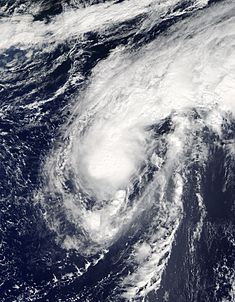Tropical Storm Karl (2016)
| Tropical Storm ( SSHWS ) | ||
|---|---|---|
| Tropical storm Karl shortly after reaching the highest intensity on September 24, 2016 | ||
| Emergence | September 14, 2016 | |
| resolution | September 25, 2016 | |
|
Peak wind speed |
|
|
| Lowest air pressure | 988 mbar ( hPa ; 29.2 inHg ) | |
| dead | No | |
| Property damage | Unknown | |
|
Affected areas |
Cape Verde Islands , Bermuda | |
| Season overview: Atlantic hurricane season 2016 |
||
The Tropical Storm Karl was a storm with little impact on Bermuda and the Kapverdeischen Islands . It was the 11th named storm of the 2016 Atlantic hurricane season . Karl formed from a tropical wave that originated off Africa on September 12th. The further development of the storm was interrupted by wind shear at the stage of a tropical depression . Nevertheless, Karl was now classified as a tropical storm because of the high level of thunderstorm activity. Karl moved west of the Atlantic, struggling with wind shear and humid air most of the time. It has since been downgraded to a Tropical Depression. On September 22nd, the wind shear weakened and Karl developed at its height as a tropical storm on September 24th. It approached Bermuda during this time, before continuing on its way north-west and moving out of the tropics the next day.
The system had the greatest impact mainly in the Cape Verde Islands during the pre-stage and in Bermuda, where no deaths were reported and only minor damage occurred.
Storm course

On September 12, the National Hurricane Center (has National Hurricane Center , NHC) began to observe a tropical wave that began to move away from the shores of West Africa. The storm began to organize and at around 3:00 p.m. UTC on September 14, it was classified as a Tropical Depression. Only a weak development due to westerly wind shear was forecast. On September 15th, an enormous increase in thunderstorm activity was noted, so that the Tropical Depression was classified as Tropical Storm Karl.
Initially, Karl was predicted that after being classified as a tropical storm, he would quickly weaken back to a tropical depression. The storm nevertheless managed to develop as a tropical storm in storm-hostile conditions. In the days that followed, Karl struggled to intensify it until, on September 21, a near wind shear weakened Karl to a tropical depression. The storm still had a closed circulation. The models missed the wind shear predictions that Karl added. Karl stayed on as a Tropical Depression for a day and a half until he began moving northwest. The wind shear eased on September 22nd and Karl turned into a tropical storm again.
The storm moved north-west and then north. Meanwhile, he steadily strengthened and organized himself as he neared Bermuda. He then made a north-easterly turn and reached the north-east of the island, but largely spared it. Karl peaked at 70 mph (110 km / h) and a minimum pressure of 988 millibars on September 25, and then went into an extra-tropical low pressure area when he reached southern Greenland .
Effects
Bermuda
Over 300 people were affected by a power failure due to a main line failure. Karl was only responsible for the power failure of 30 people and the damage remained relatively minimal. The highest wind speeds for Bermuda were between 55 and 84 km / h with gusts of up to 100 km / h.
United States
Rough seas were recorded along the east coast of the United States when Karl went out to sea.
Web links
- Karl - the extra-tropical. In: dwd.de. German Weather Service, September 27, 2016, accessed on November 28, 2016 .
Individual evidence
- ↑ a b Jack Beven: Tropical Depression TWELVE. NHC, accessed November 26, 2016 .
- ↑ Stacy R. Stewart: Tropical Storm Karl Discussion Number 7. National Hurricane Center, September 15, 2016, accessed November 26, 2016 .
- ↑ a b Lixion Avila: Tropical Depression Karl Discussion Number 28. National Hurricane Center, September 21, 2016, accessed November 26, 2016 .
- ↑ Jack Beven: Tropical Storm Karl Discussion Number 35. National Hurricane Center, September 22, 2016, accessed November 26, 2016 .
- ↑ Todd Kimberlain: Post-Tropical Cyclone Karl Discussion Number 45. National Hurricane Center, September 25, 2016, accessed November 26, 2016 .
- ^ A b Lisa Simpson: TS Karl skirts island: outages, storm surge. The Royal Gazette, September 24, 2016, accessed November 26, 2016 .
- ^ Weather: Afternoon storms forming Saturday; rip current risk high. TCPalm, September 27, 2016, accessed November 26, 2016 .
